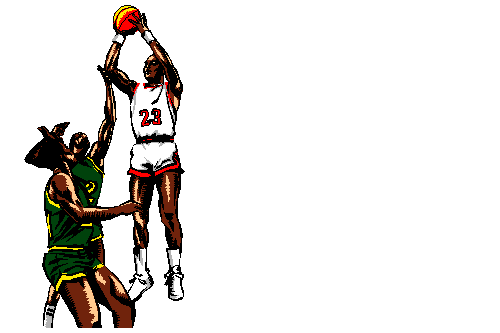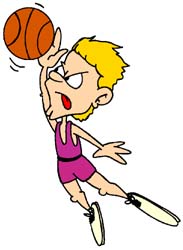Yes, you’re in the right place!
You’ll find all the correct fundamentals for a variety of basketball moves on this page.
Individual moves are a key part to the success of every team.
It’s important that you can get yourself free and create scoring opportunities in order for your team to have success.
This involves the ability to make things happen from the perimeter, inside and when you’re on the move without the ball.
Therefore, this page is divided into these three major sections.
Enjoy this comprehensive collection of basketball move fundamentals and put them to good use!
By the way, would you like to learn how to dramatically increase your speed & quickness when applying the basketball moves you’ll find on this page?
Perimeter Basketball Moves
When making any perimeter move, be sure to:
A) Look at the basket
B) Hold the ball in the “triple-threat” position
C) Maintain good balance
D) Use fakes to set up offensive moves
E) Make all your moves quickly and in a straight line to the basket
F) Read the defense so you know whether to shoot, pass or drive
Basketball Move #1) Attacking A Defender
You must be able to analyze the defender’s floor position and their feet position:
**Since your defender has to pivot before recovering and stopping your move, their front foot is most vulnerable. So, if your defender is in a staggered position, attack that front foot.
**Drive to the hoop when your defender plays with straight legs, leaves their feet or rushes at the ball.

**Take a perimeter shot when the defender backs up.
**If your defender moves laterally in response to your fake, drive to the basket in the opposite direction from your fake.
Basketball Move #2) Faking
Successful fakes will create shots, open passing lanes or open drives to the basket. Your fakes must look real and can include shot fakes, foot fakes, ball fakes, head fakes or eye fakes. You’ll usually need to use a combination of these fakes to make fool your defenders.
**Don’t straighten your legs when using shot fakes. Stay down and keep your knees bent as the ball goes up.
**Fake into your defender as much as possible when using foot fakes rather than faking to the side.
**For pass and shot fakes, ball quickness is important.
**Look in the direction of the fake with your eyes.
The following are One-on-One Perimeter Basketball Moves:
Basketball Move #3) Direct Drive
You’ll use this to drive past the defender. You don’t have to use a fake because this is used when you have an open driving lane. Your first step is most important and you must make a long, quick stride with your non-pivot foot as you push off your pivot foot. Keep your head up and accelerate past your defender by pushing the ball forward.
Basketball Move #4) Jab Step and Drive
“Jab step” toward the defender without bringing your foot back to its starting position. A “jab step” is simply a short, quick step directly at the defender using your non-pivot foot. If your defender doesn’t react to this move, push off your pivot and drive past them towards the basket.
Basketball Move #5) Crossover Step and Drive
You’ll use this if your defender does react to the “jab step”. After jabbing with the non-pivot foot, use the same foot to make a quick crossover step. You’re crossing over with a long step past your defender as you swing the ball across but close to your body. Keep your pivot foot still as you make the jab and crosover steps. Also, make sure your inside shoulder is between the ball and the defender and push the ball up the floor for the drive.
Basketball Move #6) Rocker Step
Make a foot fake by moving forward or backward. If your defender reacts to this, you’ll use the rocker step to set up a perimeter shot or a drive to the hoop. Fake a drive with a “jab step” and then rock back into the “triple-threat” position. Take a long step and drive if your defender moves forward or take the jumper if your defender drops back. Another option is to make a shot fake after you get into the “triple-threat” position. If the defender bites on that, drive in for the lay-up.
To best help you improve your speed and quickness after you’ve learned your bb moves, we’ve teamed with the Truth About Quickness team.
We encourage you to click here and gain an understanding of how this resource can help you.
If you’re a youth, high-school, college or recreational player or coach looking to dramatically improve speed & quickness, consider the Truth About Quickness…
Inside Basketball Moves
No matter your size or position you want to develop your inside game. It helps your team in a number of ways. It increases the possibility of being fouled, it provides you with high-percentage shots and opens up the three-point shot when the defense collapses inside.
Those are some pretty good reasons to be a good inside player, wouldn’t you say? Before we get to the inside basketball moves, here are some points to remember regarding your stance, getting open, reading the defense, etc:
Post-Up Stance
When in the low post, maintain a wide base with a low center of gravity. Keep your elbows out, parallel to the floor and keep your fingers spread out waiting for the pass. You want to block your defender out of the passing lane by making contact. Don’t let your defender in front of you. Be physical.
Get Open
You have to work to get open. Here are a few ideas: Step in front of the defender’s foot to get into the passing lane. Slide into openings between defenders. Fake one way and go the other. Hustle down the floor ahead of your defender. Put your foot between your defender’s feet and reverse pivot into the passing lane.
Read the Defense
You must be good at reading the defense in relation to where the ball is. If you’re defended down low, work your defender a bit lower and then post up. If you’re defended high, take your defender a couple steps higher and post up. If your defender gets in front, move closer to the ball, seal the defender off and look for a lob pass or ball reversal. If you’re guarded from behind, make contact and post up.
Think One Pass Ahead
Consider this scenario. Let’s say your teammate at the point wants to pass to you but your defender has gained position slightly in front of you and is blocking the passing lane.

Should you get upset and give up? No, make contact and keep your defender on the high side. Now, when your point teammate passes to the wing, you’re open for a pass from there. By thnking ahead, you can create new passing lanes.
How to Catch the Post Feeder
When catching passes in the post, reach out and catch the ball with both hands, bringing the ball into your chest right away. Then read the defense for your next move.
Basketball Move #7) Drop Step
Use this when guarded high. Make a rear turn with the foot closest to your defender. Make a step toward the hoop with your non-pivot foot so you seal off the defender. Take a quick, but low dribble and point your shoulder at the basket. Bring the ball up with both hands and shoot with the hand farthest away from your defender. You can also do this without dribbling. In this case, you’ll do the drop step before receiving the pass.
Basketball Move #8) Jump Hook Shot
Use the jump hook when your being defended low. Use your baseline foot as the pivot foot on a rear-turn pivot. Use your non-pivot foot to step into the lane (don’t step away from the basket, as this foot should point toward the sideline). Take a quick, low dribble and point your shoulder at the basket. When your non-pivot foot lands, swing your pivot into the lane with your chest facing the sideline. Jump off both feet, bring the ball up along the side of your head and release with full arm extension. Protect the ball with your non-shooting arm.
To perform the jump hook without dribbling, step into the lane with your non-pivot foot as before. Then raise your pivot foot, lift your knee high in the air and shoot just like we described above.
Basketball Move #9) Wheel to the Middle
Use this basketball move when your defender has taken away your drop step move. As the defender shuts off your drop step, pivot to the middle and take a jump hook shot.
Basketball Move #10) Turnaround Jump Shot
You’ll use this when you’re defended from behind or from either side. After receiving the pass, bring the ball to your chin. With the foot farthest from the defender, pivot using a front turn. Keep the ball above your chest as you pivot, square up and shoot a jump shot. You have make sure you get enough separation from the defender.
Basketball Move #11) Up and Under
This is a good basketball move to use after your defender bites on a shot fake. Pivot using a front turn and face the basket. Keep your knees bent as you bring the ball up for a shot fake. Step through quickly with your non-pivot foot as your defender is faked out. Very quickly move the ball across your body and take a long, quick step to the hoop. You can use this with a dribble or without.
Moving Without the Ball: Cutting
Did you realize that you play each game without the ball for about 80% of the time. Probably never thought of it that way, huh? But when you do, it becomes apparent that you better develop great skill at moving without the ball.
How many times have you watched a game where everyone is just standing around? Make sure you develop great awareness and vision and get good at starting, stopping, faking and changing directions (for more info on these skills, check out our basic basketball skills page – You’ll love it!)
As you perform basketball moves without the ball, you must always move with a purpose. You’re looking to set screens for teammates, get open to receive passes or clear out an area for a ball handler.
You should always strive to maintain floor balance. This includes proper spacing. Teammates should be spaced about fifteen to eighteen feet apart. As there is movement, you can’t always keep this spacing, but you want to re-establish it after screening or cutting.
What will determine when and where to cut? Where the ball and your defender are will tell you where to make your basketball moves. As you cut, push hard off the floor with quickness and cut sharp and in a straight line. Your defender will be able to beat you to your spot if you move in an arc.
Types of Cuts
Basketball Move #12) “V” Cut
This change-of-direction cut helps you move your defender in the opposite direction from your intended cut. Move slowly into the “V” cut, then push off hard and make a long stride past your defender. Have your hands up ready for a pass.
Basketball Move #13) Back Cut
Use this cut when your defender over-plays and denies you the pass. This is a basketball move behind your defender and then a cut to the basket. Push off your outside foot and then take a long stride with your other foot.
Here’s a second way to do a back cut: Pivot on your inside foot and make a long crossover step toward the basket.
Basketball Move #14) “L” Cut
Use this change-of-direction cut when your defender is in the passing lane but playing loosely “off” you. Make a move toward the defender and then push off hard and cut to the wing. This creates the shape of an “L”. It works well because it’s hard for the defender to react to your hard cut after you get close to them.
Basketball Move #15) Give and Go
This is an inside cut where you pass to a teammate, then cut to the hoop looking for the return pass. Make the pass, then use a hard “V” cut in front of your defender. This creates a passing lane by getting you between the defender and your passing teammate. Catch the pass and drive in for the lay-up.
Basketball Move #16) Clock-Down Cut
A cut to the baseline by a weakside forward to open up a passing lane as a teammate is driving to the basket. Make the cut to baseline as your teammate drives from the opposite side of the court. Getting close to the baseline as possible will open up the passing lane because your defender will usually leave you to help defend your driving teammate.
Basketball Move #17) Fish-Hook Cut
Good change-of-direction cut for when you’re being over-played and the ball handler is coming toward you. Take a few steps past you team mate and then “fish-hook” back toward the dribbler for a pass from them. Also called a “shallow cut”.
To best help you improve your speed and quickness after you’ve learned your bb moves, we’ve teamed with the Truth About Quickness team.
We encourage you to click here and gain an understanding of how this resource can help you.
If you’re a youth, high-school, college or recreational player or coach looking to dramatically improve speed & quickness, consider the Truth About Quickness…

